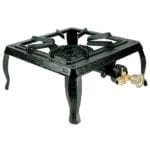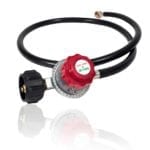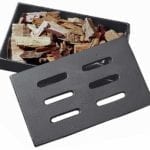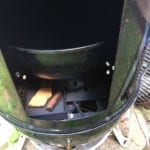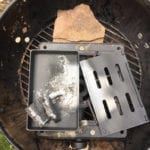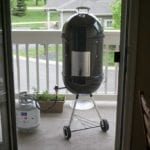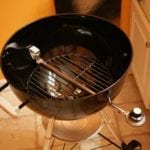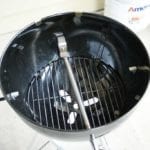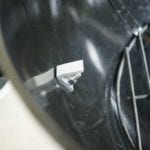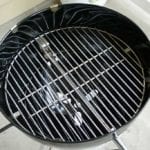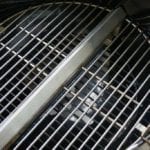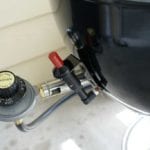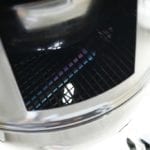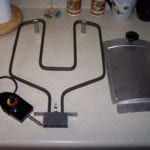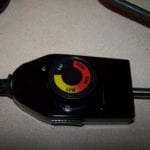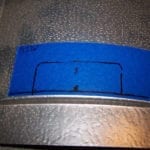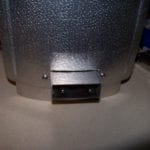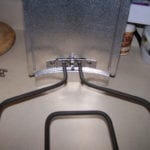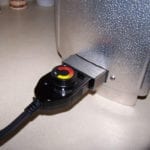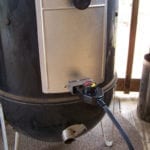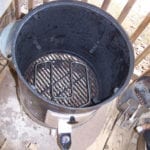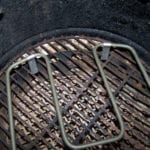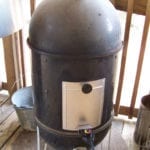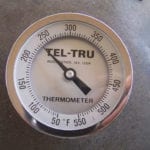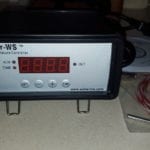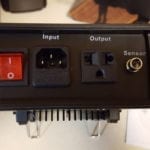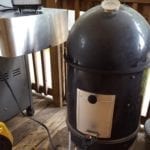Several folks have converted the Weber Smokey Mountain Cooker into a gas or electric cooker. Some people do this because they live in an apartment, condo or townhome where charcoal or gas grills are not allowed. Sometimes they do this for greater convenience and less hands-on tending of the cooker.
Gassmoker Mini-V Gas Conversion
Previously known as the Afterburner Mini-V, the Gassmoker Mini-V is designed to convert a WSM to LP or natural gas. A 1″ hole is drilled in the charcoal bowl to accept the gas burner. Smoke is generated by placing wood inside a steel can positioned over the flame.
Years ago, people reported having problems achieving low temperatures using the first-generation Mini-V with the WSM. It ran hot, and when you turned it down low the flame could go out. The current Mini-V model is supposed to be an improvement over the original.
You can visit the Gassmoker website to learn more about this product. You can also search The Virtual Weber Bulletin Board to see what people have to say about this product.
Propane Stove Conversion
EdP from Connecticut adapted a small propane stove to fire his 18.5″ WSM. He used parts similar to these:
Ed cut-out one of the bottom vents to make a hole to connect the propane hose to the stove; he also drilled several holes in the bowl for additional airflow into the cooker. The stove is used without its legs and leveled on the charcoal grate using a flat stone. Ed burns wood chunks and small split logs in the cast iron smoker box and raves about the results. He’s cooked country-style ribs, beef ribs, and baby back ribs, and is now ready to tackle a packer brisket.
You can read more about Ed’s gas conversion on The Virtual Weber Bulletin Board.
Weber Go-Anywhere Gas Conversion
Jason Hixon from Naperville, IL learned that charcoal grills were prohibited by city code in his apartment complex. He adapted parts from a Weber Go-Anywhere gas grill to create a gas-fired Weber 18-1/2″ One-Touch Silver kettle grill. By replacing the kettle lid with the WSM middle cooking section and lid, Jason’s kettle does double-duty as a gas-fired Weber Bullet.
These photos show one gas burner installed in the kettle’s charcoal bowl. One burner is sufficient for running the WSM, but Jason plans on adding two more burners for grilling purposes.
Jason added brackets to hold a charcoal grate above the gas burner. He plans on using this grate for wood chunks when smoking and for ceramic briquettes when grilling. In one photo, you’ll notice a Flavorizer bar placed over the burner to protect it from drips.
Electric Element
David Ward from McDonough, GA created an electric WSM (e-WSM) using a universal electric smoker element with adjustable thermostat and a spare access door.
“This unit has a removable thermostat and the element has flanges on both sides for connecting to the access door,” says David. “I used a Dremel tool with a flat cutting wheel to cut the opening, then drilled two holes for the 8×32 bolts.” The element is fastened to the door using stainless steel nuts, bolts and washers.
David installed the element on a spare access door so that he can easily switch between charcoal and electricity. “Just insert the element diagonally through the opening, turn upright and latch the door.” He uses an empty, foil-wrapped water pan to prevents drips from fouling the element.
For now, David has the legs on the electric element resting on a second charcoal grate placed on top of the charcoal chamber. He plans to eliminate the second grate by making a metal bracket that extends the legs to the regular charcoal grate.
As for smoke, David is using the A-MAZE-N Pellet Smoker with this setup. “I’m putting the pellet tray on the charcoal grate below the electric element and it generates smoke regardless of the element temp,” says David. “I can start with no smoke for about an hour of low heat to dry the sausage casings, then toss in the pellet tray and step up the temp every hour or so like normal sausage smoking until I get to the desired internal temp, usually 152°F.”
Describing the thermometer photo showing the electric WSM running at 235°F, David says, “This is after 30 minutes of warm-up with all vents open and the element on the highest setting. Should work great for snack sticks and sausage. I also tried it at lower dial settings. It held 125°F and 155°F with no problems and should hold anything in between.”
Update: With six months of e-WSM experience under his belt, David got tired of fiddling with the analog dial on the thermostat and added a “plug & play” Auber Instruments Model WS-1500EPM PID controller. “This particular unit was $135 and has multi-step programming capability,” says David, “so I can program it for all the temp stages by time in a snack stick or sausage smoke (x time at 120°F to dry the casings, then x time at 130°F, then x time at 140°F, etc… up to six steps). In theory, I should not have to touch a thing once it’s going with this PID.”
You can read more about David’s e-WSM conversion at The Virtual Weber Bulletin Board.
Photos of Kettle gas conversion: 2010 by Jason Hixon
Photos of electric conversion: 2015 by David Ward
Photos of propane stove conversion: 2019 by EdP

